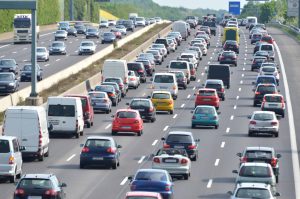Driving on the motorway can be very frustrating especially during busy periods. The Highways Agency is responsible for maintaining and improving motorways, and one of their biggest challenges is trying to reduce congestion.
The ideal scenario is to build motorways with more lanes but that is not always economically feasible and too many roadworks can cause additional congestion and delays. An alternative introduced by the Highways Agencies is smart motorways.
Smart motorways use technology to control traffic flow on the motorways. The benefit is that they increase the capacity on the motorway when required and can reduce the amount of congestion very quickly. This, in turn, improves journey time reliability.
The first smart motorway was trialled on the M42, and now they are in operation on many busy motorways including the M1, M25 and M62. It’s important for all drivers to be able to recognise smart motorways, so they drive safely and adhere to the speed limits imposed as these differ to driving on a normal motorway.
What is a smart motorway?
There are different types of smart motorways, below is a short description of each type.
- Controlled motorway – this has multiple lanes, and speed limits are varied as required to ease congestion. There is a hard shoulder, and this should only be used in emergencies, in the same way as you would use them on a normal motorway.
- Hard Shoulder running – on this stretch of motorway again there are variable speeds, but during very busy periods the hard shoulder is used to drive along. There are emergency refuge areas which can be used if your car breaks down.
- All lanes running – more of the smart motorways are being operated in this way. There are signs that tell you what speed to drive, and there is no hard shoulder. This allows all lanes to be always used, increasing capacity. There are emergency refuge areas every 2.5km.
As the emergency refuge areas are only short lay-bys, you need to notify the Regional Control Centre by calling from the roadside phone. They can monitor your situation using cameras, and when you are ready to re-join the motorway, they can assist by setting the lane signs to X so that the lane is free for you to drive onto safely.
What to look for on a smart motorway.
As soon as you drive towards a smart motorway, you will see gantries across the motorway with electronic signs showing the speed limit for each lane. When the sign shows the speed limit with a red circle as a border, it is legally binding in the same way as a fixed speed limit on a normal traffic sign. The speed limit automatically adjusts depending on the amount of congestion on the road. During busy periods the speed limit is reduced so that a steady traffic flow is maintained.
You will also see signs which show an X, which indicates that you must not drive on that lane as it has been closed. This could be because there is an accident or breakdown ahead or roadworks ahead.
Cameras in use on smart motorways
Cameras are used by Highways England to monitor the traffic flow and adjust the speed limit as required. There are also speed spot check cameras, usually mounted on the gantries. These cameras are called HADECS 3 (Highways Digital Enforcement Camera System 3), these are often called ‘stealth speed camera’ by motorists. This is because they are smaller than usual cameras and are sometimes painted grey and not the yellow we are familiar with.
These cameras don’t use film so they can take an unlimited number of photos. If they detect a car going over the speed limit they normally take three photos in quick succession to show vehicle position and vehicle identification. The cameras may be active even when the smart motorways are not operating still enforcing the normal speed limit.
Speeding Offences on the Motorway
If you commit a speeding offence on the motorway you can be dealt with in a number of ways depending upon how much you were travelling over the speed limit. You may be offered a speed awareness course, a fixed penalty notice which is £100 and 3 penalty points will be endorsed on your licence or receive paperwork for a court hearing where you will face a fine of up to £2500, court costs, a victim surcharge and 3 to 6 penalty points or a discretionary ban.
Safe Driving
Finally, it’s important to note that if you are driving on an ‘all lanes running’ smart motorway you need to be extra vigilant if you are experiencing problems with your car. Try to get to an emergency refuge area as quickly as possible and notify the Regional Control Centre and wait out of the car with your passengers behind the safety barrier. If you can’t get to a refuge then try and pull as far off the motorway as you can, ensure you and your passengers are in a place of safety by exiting via the passenger doors and call the emergency services and your breakdown provider. The cameras usually detect breakdowns and respond quickly but always put safety first.
We hope you found this article useful if so, have a look at our blog page for more tips on driving safely and updates on motoring law.
If you need any support from our expert motoring law team, then call today for a free initial consultation on 0115 784 1588 or email maria@mooremotoringlaw.co.uk






